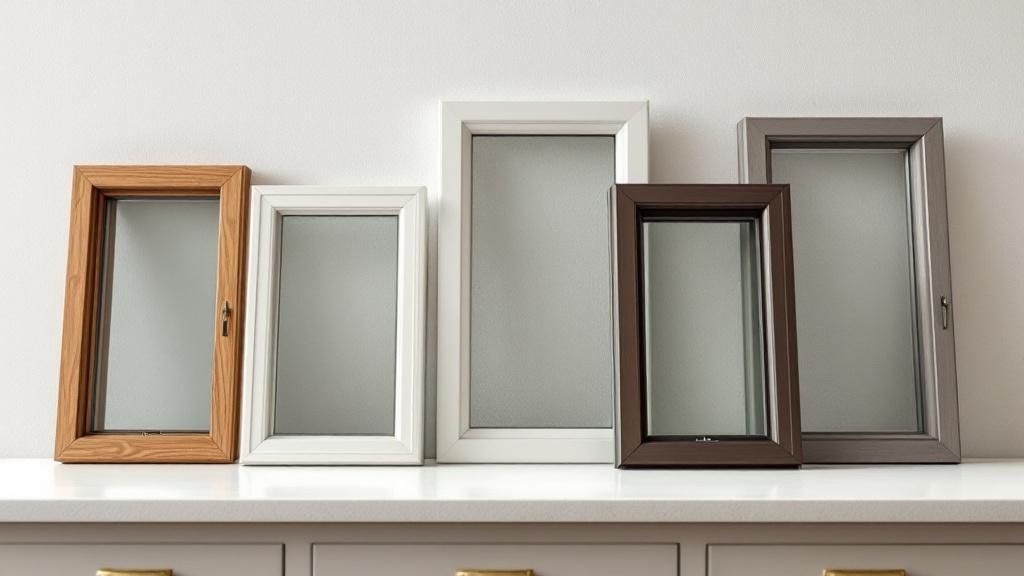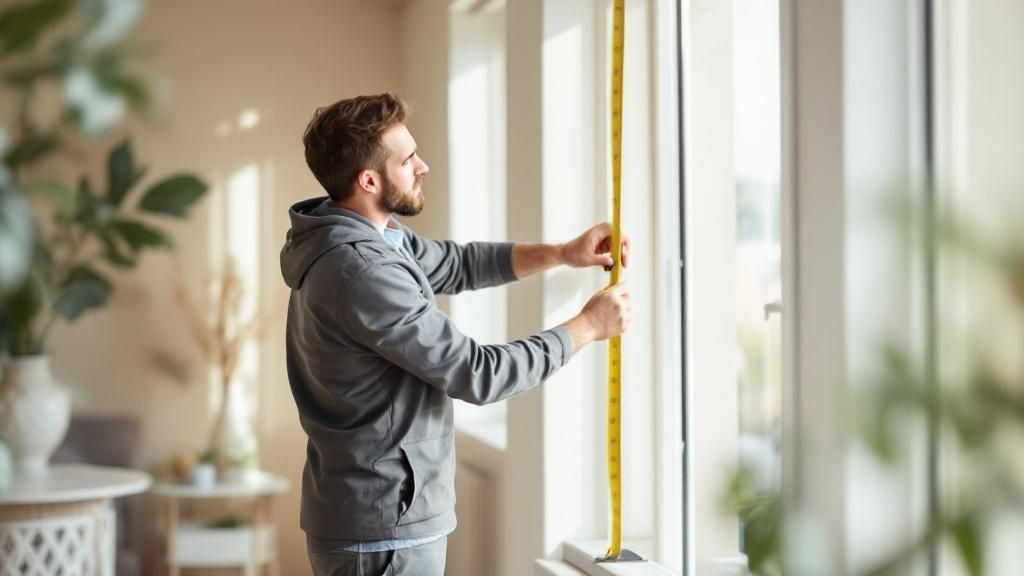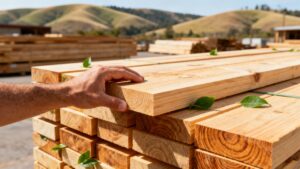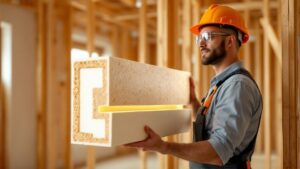Planning a window replacement in the Bay Area isn't just about upgrading your home's look—it's a significant investment in your property's value and comfort. While every project is unique, a good window replacement cost estimator starts with understanding the key variables. This guide gives builders, homeowners, and remodelers in Berkeley, Oakland, and across the Bay Area a realistic look at project expenses.
Understanding Bay Area Window Replacement Costs

Whether your project is in Berkeley, Oakland, or anywhere across the San Francisco Bay Area, careful budgeting is the first step. The final cost of new windows is a unique blend of material choices, our region's specific building codes, and your home's architectural style. Getting a handle on these factors is how you build an accurate financial plan.
To get our bearings, let's look at national numbers. According to Energy Star, replacing old windows with ENERGY STAR certified windows can save homeowners an average of $101–$583 a year when replacing single-pane windows. While specific replacement costs vary, a 2024 analysis by Angie's List notes a national average cost between $300 and $2,100 per window, including installation.
A Quick Look at Average Window Replacement Costs
This table offers an at-a-glance summary of national average costs. Think of these figures as a starting point before you factor in the specifics of a Bay Area project, which often involves higher-performance materials and specialized labor from a "lumberyard near Oakland" or your local supplier.
| Cost Metric | Average Price Range (Per Window) |
|---|---|
| National Average Cost | $300 – $2,100 |
| Low-End (Basic Vinyl) | $300 – $750 |
| Mid-Range (Fiberglass/Composite) | $500 – $1,500 |
| High-End (Wood/Clad-Wood) | $1,000 – $3,000+ |
Source: Data compiled from industry reports and sources like Angie's List.
Remember, Bay Area costs are often higher due to our unique climate, stringent energy codes, and market dynamics.
Key Factors That Influence Your Window Estimate
What pushes a project toward the lower or higher end of that spectrum? Before using a cost estimator tool, you need a good handle on these key variables:
- Window Material: Vinyl is usually the most budget-friendly choice. Fiberglass sits in the middle, offering great durability for the Bay Area climate. For top-tier aesthetics and performance, you’ll look at premium materials like wood and aluminum-clad wood from brands like Marvin, which naturally command a higher price.
- Window Type and Style: A standard single-hung or double-hung window is far more affordable than a large bay window, a curved bow window, or a custom-shaped architectural piece.
- Glazing and Energy Efficiency: This is a big one in California. Features like double or triple-pane glass, low-E coatings, and argon gas fills are often necessary to meet the state's Title 24 energy standards. They add to the upfront cost but pay dividends in energy savings.
Here in the Bay Area, our microclimates and strict energy regulations almost always demand higher-performance windows. Local estimates will likely start higher than the national average, but you'll feel the difference in your energy bills.
For professionals and homeowners alike, understanding the full scope of options for windows and doors in the San Francisco Bay Area is the most critical part of planning. This knowledge helps you make smart decisions that balance budget, performance, and design vision.
Breaking Down Your Window Replacement Estimate

When you receive a quote for new windows, it's more than a single number. A detailed estimate is your best tool for understanding exactly where your money is going and avoiding surprises.
Your total cost is a mix of materials (the windows) and labor (the installation). Other charges can, and often do, pop up—especially when working on an older Bay Area home.
Unpacking Material Costs by Frame Type
The materials you select will have the biggest impact on your project's bottom line. The window frame is the main driver here, with choices that run from practical to premium.
- Vinyl: This is usually the most budget-friendly option. Vinyl windows offer good energy efficiency and require minimal upkeep.
- Fiberglass: A solid mid-range choice, fiberglass is incredibly strong. It holds up well against the Bay Area’s temperature swings without expanding or contracting.
- Wood and Wood-Clad: For sheer beauty and natural insulation, it’s hard to beat premium wood windows. Wood-clad versions add a layer of aluminum on the outside to protect the wood, creating a high-end, long-lasting solution that naturally comes with a higher price tag.
Once you’ve settled on materials, the next major piece of the puzzle is the complexity of the installation.
Factoring in Labor and Project Complexity
Labor isn't just about swapping an old window for a new one. According to Angie's List, a straightforward installation might cost $100 to $400 per window in labor. For more complex jobs, that figure can easily jump past $800 per window.
What makes one job more involved than another? In historic Berkeley or Oakland neighborhoods, we see these factors all the time:
- Structural Modifications: If your new window is a different size than the old one, the opening must be reframed. This is common in remodels where you might be enlarging an opening for more light.
- Access Issues: A second-story window or one in a hard-to-reach spot takes more time, specialized equipment, and extra safety measures to install correctly.
- Repairing Hidden Damage: You never know what you’ll find until you pull the old window out. It’s common to uncover hidden rot or water damage in the wall, which must be fixed before the new window can go in.
Don't forget the small stuff. Things like hauling away old windows, installing new trim, and painting can add up. A thorough estimate from a professional will account for every detail.
How Bay Area Codes and Climate Affect Your Budget

If you're using a window replacement cost estimator for a Bay Area project, you must look beyond national averages. Our region has a unique mix of tough building codes, varied microclimates, and historic preservation rules that all impact the final cost.
From the chilly fog in San Francisco to the sun-baked hills of the East Bay, your windows have a tough job. High-performance windows are essential for keeping your home comfortable and your energy bills in check, which is where California's building codes come into play.
Navigating California Title 24 Energy Standards
The California Energy Commission’s Title 24 standards are some of the most rigorous in the country. To be compliant, your new windows need features that add to the price tag:
- Low-E Coatings: This microscopic, transparent coating on the glass reflects heat, keeping your house cooler in summer and warmer in winter.
- Double or Triple-Pane Glass: Two or three panes are separated by an inert gas like argon, which dramatically slows down heat transfer and improves insulation.
- Low U-Factor and SHGC Ratings: You'll need to hit specific targets for U-Factor (how well it insulates) and Solar Heat Gain Coefficient (how well it blocks the sun's heat). These targets change depending on your specific Bay Area climate zone.
Meeting these standards is mandatory for most replacement projects. It’s a huge reason why window projects here cost more than in other parts of the country. You can dive deeper in our guide on how to choose the right energy-efficient windows for Bay Area homes.
Special Considerations for Bay Area Projects
On top of energy codes, other local issues can affect your budget. Builders, architects, and homeowners need to factor these in for a realistic estimate.
- Seismic Requirements: We live in earthquake country. Window installations must follow specific structural rules to ensure they're secure, which can add to the labor bill.
- Historic Preservation: In historic neighborhoods in Berkeley, San Francisco, or Alameda, you might be required to use specific window styles or materials, like true divided-lite wood windows, to preserve the home's character. These custom windows are worlds away from standard vinyl in terms of cost.
When budgeting for a window project in a historic home, always account for a potential 20-30% increase in costs for custom fabrication and specialized installation to meet preservation guidelines.
Using a Cost Estimator Tool for Your Project
A window replacement cost estimator is a great way to get a budget in mind, but its output is only as good as the information you provide. To get a useful ballpark figure, you need to have specific details about your project.
Think of it this way: walking into a supplier discussion armed with an estimate makes you a more informed customer. The goal isn't a binding quote from a calculator, but to educate yourself on cost drivers. This way, the conversation with a professional at a Berkeley building materials supplier like Truitt & White will be much more productive.
Gathering Your Project Details
Before opening an online calculator, get your details in order. The more specific you are upfront, the more realistic the initial estimate will be.
Here’s what you should have handy:
- Window Measurements: Get an approximate width and height for every window you plan on replacing.
- Window Style: Know what you want. Are you looking for classic double-hung windows, modern casements, or easy-to-use sliding windows?
- Frame Material: Have a preference in mind, whether it's budget-friendly vinyl, durable fiberglass, or a premium choice like wood or wood-clad frames.
This quick visual breaks down the flow of most estimator tools.

As you can see, the process is straightforward: your inputs directly shape the cost estimate, showing you in real-time how choices affect the bottom line.
How Frame Materials and Window Styles Affect Price
The choices you make for frame material and window style have the biggest impact on your total cost. Some options are inherently more expensive due to materials, manufacturing complexity, and features.
Here's a general comparison to help you understand the cost hierarchy.
Material And Style Cost Impact Comparison
| Factor | Low Cost Option | Mid-Range Option | High Cost Option |
|---|---|---|---|
| Frame Material | Vinyl | Fiberglass | Wood, Wood-Clad, Aluminum |
| Window Style | Fixed/Picture | Single-Hung, Sliding | Double-Hung, Casement, Bay/Bow |
This table gives you a good sense of the landscape. Vinyl and fixed windows are typically your most economical choices, while custom wood-clad bay windows will sit at the higher end of the price spectrum.
Interpreting Your Estimate
Once you've received a number, you need to know what it really means. A digital estimator provides a rough estimate—a starting point, not a formal quote. It calculates costs based on standard sizes and national averages, so it can't account for the unique variables of your Bay Area project.
Think of the estimator's result as the beginning of a conversation. It's a fantastic tool for initial budgeting, but it's not the final word. It won't factor in local labor rates, permit fees, or hidden issues common in older Oakland homes.
Use your estimate to ask better questions. Approach a window expert and say, "My online estimate for ten wood-clad windows was 'X'. What factors specific to my Berkeley house might change that number?" This shows you've done your homework.
To dive deeper into the variables, our guide on choosing energy-efficient windows is a great resource.
The Long-Term Value of Quality Windows
The number from a window replacement cost estimator is just the starting point. Think of a quality window replacement not as an expense, but as an investment that pays you back over the years.
According to the U.S. Department of Energy, heat gain and loss through windows account for 25%–30% of a home's heating and cooling energy use. Upgrading to modern, energy-efficient windows that meet California’s Title 24 standards plugs a major energy leak, resulting in real savings.
Benefits Beyond Energy Savings
While everyone loves a lower energy bill, the day-to-day benefits are just as valuable. These perks genuinely improve how it feels to live in your home.
- A More Comfortable Home: High-performance windows eliminate drafts and hot spots. This keeps your indoor temperature stable, whether you're in foggy San Francisco or sunny Oakland.
- A Quieter Space: Double or even triple-pane glass is fantastic at blocking outside noise. It can transform a noisy urban street into a peaceful retreat.
- Better Home Security: Modern windows are built with far superior locking mechanisms and stronger materials, giving you an extra layer of security and peace of mind.
A window replacement project consistently ranks among the home improvements with the highest return on investment. It signals to buyers that a home is well-maintained and energy-efficient—a huge selling point in the eco-conscious Bay Area.
Investing in a Growing Market
The Joint Center for Housing Studies of Harvard University reported that the home improvement market reached an estimated $472 billion in 2022. This growth shows that homeowners and builders are focusing on energy efficiency and long-term value.
When you choose high-quality windows from trusted brands, you aren’t just buying a product. You’re investing in your property’s future worth, comfort, and performance.
Frequently Asked Questions (FAQs)
1. Do I need a permit to replace windows in the Bay Area?
Yes, in most Bay Area cities like Berkeley and Oakland, replacing windows is considered a structural alteration and requires a permit. This ensures the new windows and installation meet current building codes, including California's Title 24 energy standards and local seismic rules. A licensed contractor can manage this process for you.
2. How long does a typical window replacement take?
For a few standard-sized windows, an experienced crew can often finish in one or two days. However, lead times for custom orders can take several weeks. Projects involving structural changes or repairs to hidden water damage will also extend the timeline.
3. Is it cheaper to replace all windows at once?
Yes, replacing all your windows at once is almost always more cost-effective. You save on labor and setup costs by avoiding multiple projects, and you may get a better price by ordering materials in bulk. This also ensures a consistent look and energy performance throughout your home.
4. What is the best window material for the Bay Area climate?
For many Bay Area homes, fiberglass is an excellent choice as it is durable, energy-efficient, and resists expansion and contraction. However, wood and wood-clad windows offer premium aesthetics and insulation, perfect for historic homes, while vinyl remains a popular, budget-friendly option with solid performance. Your choice depends on budget, style, and performance needs.
5. How do I know if my windows really need replacing?
Obvious signs include cracked panes or rotting frames. More subtle signs are persistent drafts, condensation between glass panes, and difficulty opening or closing them. A noticeable increase in your heating or cooling bills is also a major red flag that your old windows are no longer efficient.
Ready to turn your estimate into a reality? The experts at Truitt & White can provide a detailed, accurate quote based on your specific project needs. Visit our Berkeley showroom or connect with us today for professional advice on "Bay Area windows and doors."









